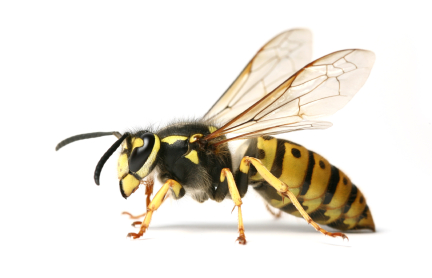Biology and Life Habits

There are several species of wasps that are commonly found throughout Canada. Some of the more common ones you may encounter are the Yellow Jacket, Bald Faced Hornet and Paper Wasp.
The color of these wasps can range from yellow and black to combinations of black, yellow, brown and orange. Most of the wasps are slim bodied, with an overall length of 10 to 19mm (1/2” to ¾”). All wasps have chewing mouth parts and the female possesses a stinger.
The wasp colony consists of Queens (fertile females), Worker (sterile females) and Males. In the late summer, early fall, the Queens and Males mate, then the Male and Workers die off and the Queen over winters in a protective site.
In the spring, the fertilized Queen collects plant and fiber and other cellulose material and mixes it with saliva to construct a typical paper type nest. Nests can contain as many as 10,000 to 30,000 individuals.
Questions and Answers
Q. Are wasps hazardous to humans?
A. Yes. A wasp sting, aside from being very painful can prove to be very fatal to people who are highly allergic.
Q. Do all wasps sting?
A. No. Only the queens and workers possess an ovipositor (egg-laying tube) which forms the stinger. Normally the stinger is used to kill prey on which wasps and their larvae fee, but will use it on animals and man if provoked.
Q. Do wasps die off in cold months?
A. Yes. Only the new queens survive the winter while the rest of the colony dies off when weather becomes cold. The queen over winters under loose bark or in crevices and lays egg in the spring to start a colony.
Q. Can weather conditions affect the size of a wasp infestation?
A. Yes. An abnormally cold, we spring or hot, dry summer can have an effect on the size of a wasp colony.
Q. Can I do anything to prevent the wasp activity on my property?
A. Yes. Whenever possible, try to eliminate fallen fruit and refuse which will attract wasps. Sealing holes and other potential sites may help prevent nesting. Once a nest is established do not seal the hole until after treating and there is no more activity.
Q. Do wasps cause damage?
A. No. Since they feed on flies and other insects, they are considered beneficial. However, because they are attracted to sweet substances such as fresh fruit and juice, their presence can prove to be a nuisance.
Q. When are wasps most common?
A. During warm spring and summer months when workers are foraging for food.
Q. When am I most likely to see wasps?
A. Wasps are most active during the daylight hours.
Q. Where do you find wasps?
A. Wasps are social insects and build paper-like nests made from wood fibers and other plant material mixed with saliva. Nests can be found around buildings on verandas, under eaves, ceilings, attics or in trees and shrubs. Several varieties of wasp build nests underground.
Preparation Guidlines for a Wasp/Bee Treatment
1. The Reliable technician will be injecting an insecticide directly in the nest to kill all stages of the insect present in the nest. If possible, the technician will remove the nest. A few wasps/bees that are out of the nest at the time of the treatment may return to the area, but upon discovering that a treatment has been done, the wasps will disperse from the area or die.
2. If treatment is done inside the home, vacate the premises during the service and do not re-enter until at least 4 hours after treatment. Open windows for 20 minutes after re-entry if possible
3. Avoid the area treated for 24 hours since wasp activity may increase in the immediate vicinity of the nest during this period of time.
